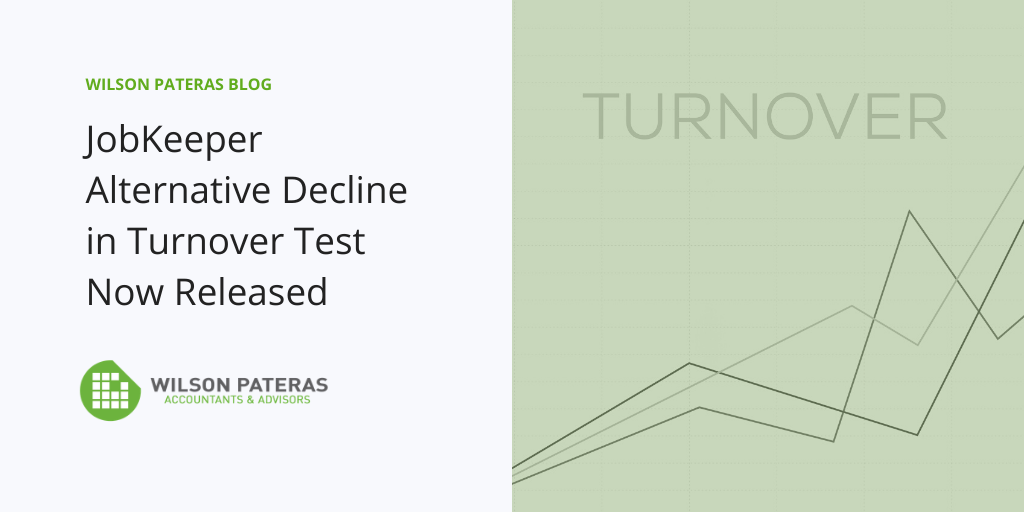
The JobKeeper new alternative tests have been released and remain broadly in line with the original, with the same seven circumstances available to entities where there is not an appropriate relevant comparison period in 2019. These include businesses:
- that started after the comparison period
- that acquired or disposed part of the business
- where a business restructure changed the entity’s turnover
The alternative tests also account for businesses that had a substantial increase in turnover, were affected by drought or natural disaster, have an irregular turnover, and had sole traders or small partnerships that experienced sickness, injury or leave during the comparable period.
A key difference in the updated alternative tests is that current GST turnover is now used in place of projected GST turnover, in line with the basic decline in turnover test for the JobKeeper extension from 28 September.
Changes to the ‘substantial increase in turnover test’
Entities that experienced a substantial increase in their current GST turnover will now be able to choose between using the period immediately before the turnover test period or before 1 March 2020.
Changes to the ‘irregular turnover test’
A similar change has been made for businesses looking to access the irregular turnover test, with a choice of now using the period immediately before the applicable turnover test period or before 1 March 2020.
Changes to multiple disposals, acquisitions and restructures
The new alternative test removes the requirement for entities with multiple acquisitions, disposals and restructures to use the period after the last of the sequential transactions.
Where an entity has had multiple acquisitions, disposals or a sequence of restructure transactions at or after the start of the relevant comparison period but before the applicable turnover test period, the entity may apply these tests to each acquisition, disposal or restructure separately.
Sole trader or small partnership with sickness, injury or leave
The new alternative test for sole traders or partnerships affected by the sole trader or a partner not working for all or part of that period due to sickness, injury or leave has also been updated.
The revised test now uses the current GST turnover for the month immediately before the month in which the sole trader or partner did not work, rather than the turnover for the month immediately after the month in which they returned to work.
Some Examples
Example 1: Substantial increase in turnover
Before 1 March 2020, Blue Co had an increase in current GST turnover and wants to ascertain whether it can apply, and satisfy, the alternative test under section 10 of this instrument.
Blue Co uses its current GST turnover of $150,000 for the turnover test period of the quarter ending 30 September 2020. Blue Co’s current GST turnover for the month of February 2019 was $50,000 and its’ current GST turnover for the month of February 2020 was $80,000.
Blue Co applies the alternative test under section 10 of this instrument as its current GST turnover for the month of February 2020 increased by $30,000 from the current GST turnover for the month of February 2019 of $50,000 and $30,000 is more than 50% of $50,000.
The following monthly current GST turnovers were recorded by Blue Co:
| Month | Current GST Turnover recorded by Blue Co |
| December 2019 | $70,000 |
| January 2020 | $75,000 |
| February 2020 | $80,000 |
Blue Co’s 3 months’ current GST turnover is $225,000 and compares this with the current GST turnover for the quarter ending 30 September 2020 of $150,000. Blue Co finds that its current GST turnover for the quarter ending 30 September 2020 falls short of the 3 months’ current GST turnover by $75,000, which is greater than 30%. The alternative decline in turnover test is satisfied.
Example 2: Irregular turnover
Red Co has an irregular current GST turnover which is not cyclical and wants to ascertain whether it can apply, and satisfy, the alternative test under section 11 of this instrument.
Red Co uses its current GST turnover of $100,000 for the turnover test period of the quarter ending 30 September 2020. Red Co had the following current GST turnovers for the 4 consecutive 3-month periods in the 12 months before 1 March 2020:
| 3-month periods pre‑1 March 2020 | Current GST Turnover recorded by Red Co |
| March, April and May 2019 | $150,000 |
| June, July and August 2019 | $100,000 |
| September, October and November 2019 | $75,000 |
| December 2019, January and February 2020 | $200,000 |
Red Co applies the alternative test under section 12 of this instrument as Red Co’s lowest current GST turnover 3-month period of $75,000 is less than 50% of the highest current GST turnover 3-month period of $200,000.
The average monthly current GST turnover is the total current GST turnover from the 12 months before 1 March 2020 ($525,000) divided by 12. This gives Red Co an average monthly current GST turnover of $43,750. Red Co multiplies this number by three to get $131,250 and compares it to the current GST turnover for the quarter ending 30 September 2020 of $100,000. Red Co finds that its current GST turnover for the quarter ending 30 September 2020 falls short of the figure worked out using the alternative test by $31,250, which is less than 30%. The alternative decline in turnover test is not satisfied.
This is a highly technical area and we recommend that you speak to your Wilson Pateras Accountant on 03 8419 9800 to assess your eligibility asap.
View the new alternative tests legislative instrument here.
View the accompanying explanatory statement here.
Ref: Accountants Daily





